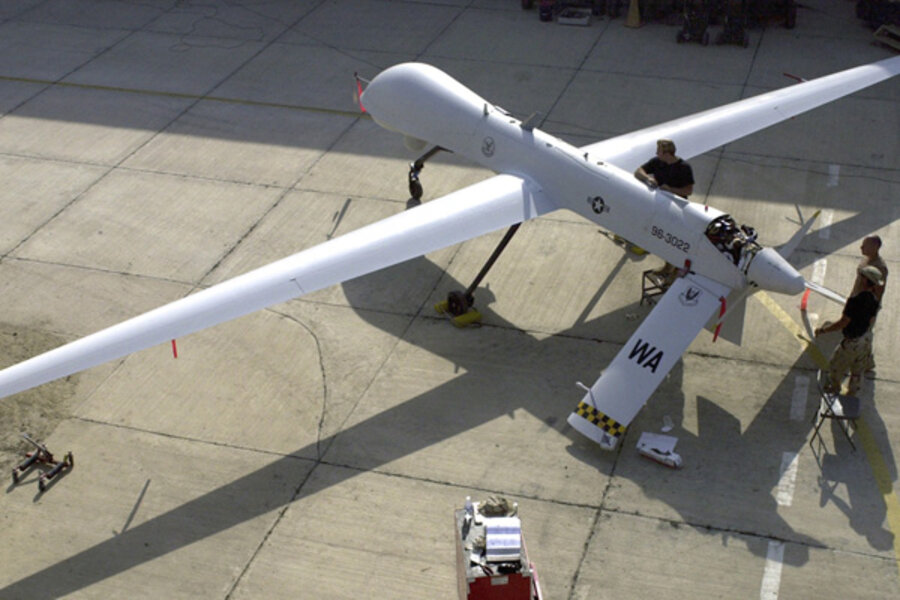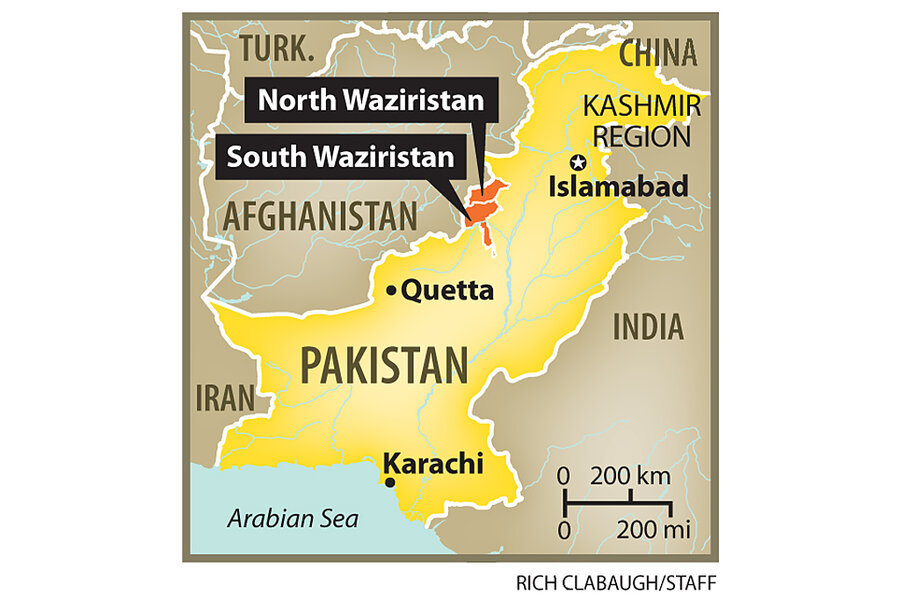US drones are pounding Pakistan's North Waziristan. Here's why.
Loading...
| Karachi, Pakistan
After a CIA Predator drone fired a missile in the village of Issori in North Waziristan last month, Jamshed Khan and other tribesmen rushed to the mud home that was the target. Mr. Khan recalls that as the tribesmen started to remove bodies, a group of men drove up, offered prayers for the victims, and left.
The tribesmen say the visitors were well known: Some belong to Al Qaeda and some are the followers of powerful leader Hafiz Gul Bahadur, who once had ties to Tehrik-e-Taliban Pakistan (TTP), the main Taliban umbrella group there.
Thousands of TTP militants fled here after last year’s military crackdown in South Waziristan, adding to the already mixed crowd of militants seeking shelter there post-9/11. And despite diverse nationalities, they appear able to work in sync.
CONSIDER THIS: 5 key players in Pakistan's tribal belt
“Our bonding force is our common cause of waging jihad in Afghanistan,” says Azam Tariq, TTP spokesman. Their ultimate goal, he says, is to implement sharia law. “Then why wouldn’t we be united?”
That unity has prompted the United States to urge Islamabad to again crack down – this time, on North Waziristan. But Pakistani security officials are hesitant to get involved there.
“You have to hold the ground permanently after cleaning up the militants rather than leaving the footprints of boots,” says a senior security official, citing military operations in Swat, Bajaur, South Waziristan, and other areas, as well as the Army’s commitment to help victim’s of the country’s devastating floods.
That reluctance appears to have driven a new US predator battle against Al Qaeda and Taliban commanders and militants who turned North Waziristan into what analysts are calling one of the most dangerous places in the world.
Since early this month, the US has launched 12 drone attacks on mud houses believed to be militant hideouts or training centers, killing 77 people including foreign militants.
Old Jihadi contacts to get new alliances
Commanders use their old jihadi contacts to recruit young warriors into their own training camp. The head trainer usually belongs to Al Qaeda, but now contacts are broadening to create a more complicated network of alliances.
The Punjabi Taliban – so named for their roots out of southern Punjab, and distinguishable by the fact that their members do not speak Pashto and traditionally have ties with groups such as Jaish-e-Mohammed – now operate out of North Waziristan and fight alongside Pakistani Taliban and Al Qaeda.
With shoulder-length hair, and armed with Kalashnikovs and rockets, these young militants roam around in four-wheel-drive jeeps.
“They are loud and short-tempered and fight among themselves. They show off, unlike Arabs who are generally quiet, maintain a low profile, and mostly use ordinary cars like us,” says Javed Wazir, a local tribesman.
The Arabs he refers to are highly trained Al Qaeda militants of Moroccan, Egyptian, Algerian, and Sudanese origin, operating under the command of Mustafa Abu-al-Yazid, also known as Sheikh Saidal Masri, who was killed in May this year in a drone attack. Now, Siraj Uddin Haqqani, the most powerful militant in Waziristan is believed to coordinating with these Al Qaeda militants.
Al Qaeda militant hideout
According to US estimates, there are about 2,000 Al Qaeda militants in the region. Their main hideouts, the prime target of US drones in the spring, are located in the mountains between Miramshah and the Afghan border. Additionally, there are Uzbeks, Chinese Uighurs, Chechens, and Tajik militants collaborating in North Waziristan.
It is estimated that around 3,000 Uzbeks (not to mention a number of militants belonging to other Central Asian states) have taken shelter in the region.
Since last year’s killing of Tahir Yledeshev, chief of the Uzbekistan Islamic Movement, there have been splinters, but Uzbeks mainly fight alongside TTP leaders.
There is also a group of hundreds of militants belonging to the East Turkestan Islamic Movement (ETIM), a separatist extremist movement of Uighurs fighting against China for the independence of Xingjian Province. The commander, known as Abdul Shakoor, succeeded Abdul Haq al-Turkestani after he was killed in a drone attack early this year.
Intermarriages help
Tribesmen say they have attended at least two marriages of Uzbek commanders to local girls. Sources say that intermarriages between the foreign militants and tribal families indicate that the bonding has strengthened cross-recruitment and connections.
Once new militants are trained, they are sent to towns along the Pakistani-Afghan border to the camps of the Haqqanis and Mr. Bahadur before crossing into Afghanistan, using connections there.
“Pakistan’s resistance to go into North Waziristan stems from the fact that mostly, Pakistani militants are nestled under the banner of Siraj Haqqani and Gul Bahadur and Al Qaeda,” says Imtiaz Gul, author of the book “The Most Dangerous Place.”
“The apprehension is that if we [Pakistanis] launch [a] full-scale operation in North Waziristan, we will also face severe backlash in the cities,” he says.
CONSIDER THIS: 5 key players in Pakistan's tribal belt






